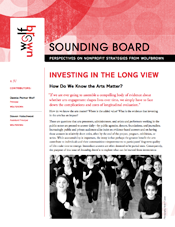 No. 31 | published 2013
No. 31 | published 2013Investing In the Long View
How do we know the arts matter? Where is the added value? What is the evidence that investing in the arts has an impact? These are questions that arts presenters, administrators, and artists and performers working in the public sector are pressed to answer daily" />
 No. 31 | published 2013
No. 31 | published 2013
Investing In the Long View
How do we know the arts matter? Where is the added value? What is the evidence that investing in the arts has an impact? These are questions that arts presenters, administrators, and artists and performers working in the public sector are pressed to answer daily
Investing In the Long View
How Do We Know the Arts Matter?
by Dennie Palmer Wolf & Steven Holochwost
“If we are ever going to assemble a compelling body of evidence about
whether arts engagement shapes lives over time, we simply have to face
down the complications and costs of longitudinal evaluation.”
How do we know the arts matter? Where is the added value? What is the evidence that investing in the arts has an impact? These are questions that arts presenters, administrators, and artists and performers working in the public sector are pressed to answer daily—by public agencies, donors, foundations, and journalists. Increasingly, public and private audiences alike insist on evidence-based answers and on having those answers in relatively short order, often by the end of the project, program, exhibition, or series. While accountability is important, the irony is that perhaps the greatest benefit the arts contribute to individuals and their communities—improvements to participants’ long-term quality of life—take time to emerge. Immediate answers are often doomed to be partial ones. Consequently, the purpose of this issue of Sounding Board is to explore what can be learned from investments in the long-term results of arts engagement at the individual, institutional, and community levels.
{jcomments on}

